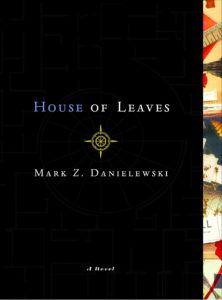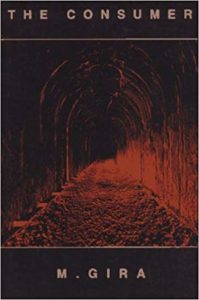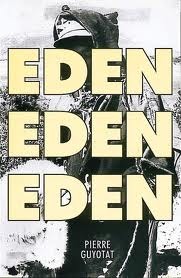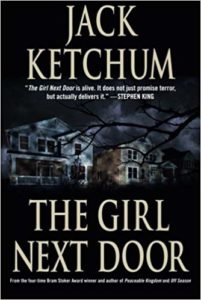Tis the season to scare yourself shitless. Readers have been asking for fresh, new scares across lists, conversations, Twitter threads, and you may think this list is yet another in the sea of lists. But I’m here to give you a very different look at what will leave a mark. But let’s get one question out of the way: You want true terror, right? I’m not talking a little chill or a tiny knot in your throat; I’m talking books that leave such an impression on you, they keep you up at night. They keep you distracted during the workday, mumbling warnings to your friends… empathetically not wanting to recommend the book while simultaneously wanting them to share in your terror just so you don’t have to be alone with it. The following books exist as vessels of terror, and I present them to you unabashedly. Reader beware. For real. Beware.

House of Leaves by Mark Z Danielewski
I may be a little biased with this one, given that I wrote a book about the book, but after asking literary Twitter about the scariest reads, this book consistently popped up as the one that left scars, frightening countless readers for decades. Simply stated, it’s about a house that’s bigger on the inside than it is on the outside, whole hallways and rooms appearing in the night. There’s far more to it though, a true deep dive into madness and love. The book is one that you should experience at least once in your life. Just like if you care about horror at all, you should have already viewed The Shining at least once.

Uzumaki by Junji Ito
The infamous manga series that gets name-dropped frequently by horror fans everywhere, Uzumaki is about a fictional city that is plagued by one of the strangest and most clever curses possible: a pattern. Think what Pontypool Changes Everything does for language as a vessel for a zombie plague but instead it’s the pattern itself, spiral haunting townsfolk, appearing wherever they look. Such a genius premise, and it gets weird. Weird with a capital W. This one stands out as one of the greatest horror manga but is constantly mentioned in whisper rather than adamant shout, probably because it’s just that terrifying.

Women Talking by Miriam Toews
This book will likely be the biggest departure in this list, not because of its volume of terror, but rather because it exhibits a breed of terror that gets under your skin. It isn’t the outright fear that’ll get you; rather, Toews’ novel will terrify you for it’s accountability. Based on a true story, it follows eight Mennonite women escaping trauma: a colony where they have been held captive, drugged and illiterate, while being used as sex slaves by the colony’s men. The secret revealed, the women face a dire choice—remain in the colony or escape. The novel is as shocking as it is saddening, and it’s one of the most important novels in recent history.

The Tenant by Roland Topor
This one might be more familiar, seeing how it was adapted into an eponymous film by Roman Polanski in the 70s, but the novel is so much darker and dire than the film ever could produce. The terror within Torpor’s initially quiet and eerie novel is uncanny, the closest comparison I can give would be Franz Kafka’s The Metamorphosis on downers. The Tenant is about a man named Trelkovsky who moves into an apartment building and is systematically driven mad by horrible yet easily erased and/or denied occurrences around the building. We’re talking simple terrors like strange noises in the night, to a nearby neighbor watching from an adjacent window without any care of being found out, but then it lengthens to invade the tenets of privacy. A must-read.

The Consumer by M. Gira
I’ll provide a disclaimer for this one, but it’s just too disturbing to not be included in this list: This book is hard to find. Long out of print and word has it the author, Michael Gira of Swans fame, doesn’t want it back in print. Still, Gira managed to create one of the most gruesome and vile collections of stories any reader may ever encounter. The book feels a lot like something you’d stumble upon in a dark alley at 3AM, some anomalous partially tampered with package, as curious as it is obviously a danger. The stories contained within are goth as hell and consist of pretty much every atrocity there is—torture, self-mutilation, murder, bestiality, etc… It’s most definitely the most disturbing book on this list… except maybe one other. But I’ll get to that.

Eden, Eden, Eden by Pierre Guyotat
It’s only fitting to follow up The Consumer with Pierre Guyotat’s legendary work of terror, Eden, Eden, Eden. The French author, Pierre Guyotat is known in many literary circles that dare to explore the darker side of literary horror as a master of experimental literature. His books defy categorization and the same can be said for Eden, Eden, Eden, which lacks any subjects or characters, and is instead constructed to be absent of discourse, leaving pure atrocity. It’s an infectious and alarming text, the closest comparison might be J.G. Ballard’s The Atrocity Exhibition. Still, there’s really quite nothing else like this one.

Song for the Unraveling of the World by Brian Evenson
Brian Evenson has been a master of horror for quite some time now. With multiple collections and novels that track an impressive range, including the cult classics, Altmann’s Tongue and Last Days, his latest collection is, quite simply, a masterclass in horror. From the first story alone, which (no spoilers) consists of a faceless teenage girl and the terror that permeates the people that know her, Evenson sets the tone for a varied and versatile collection of scares. This is the best primer for scaring yourself to the brink. And it’s so, so good.

The Girl Next Door by Jack Ketchum
This is the most terrifying book ever. Bold statement but it’s a book that’s beyond the beyond, so bold we’re talking full dark, jet black and full of destruction. Based on the true story of the murder of Sylvia Likens, which you might want to Google first, just so you know what you’re getting into with this book, Jack Ketchum took a horror so bleak and terrifying it had to be real first in order to be fictionalized. The result is a book that defines what true terror is, and it’s a book that I recommend only if you want to know the limits of (true) terror.

















